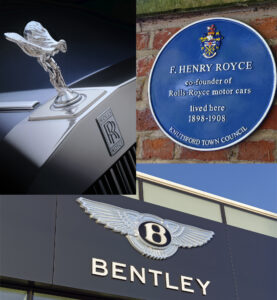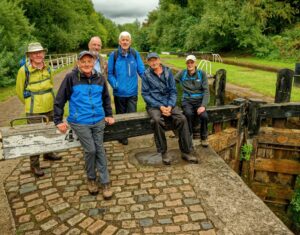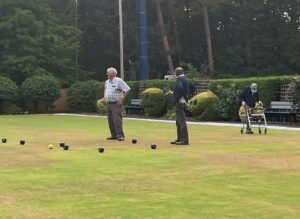Thursday 11th September 2025 – Club Meeting – Speaker John Wain, to give a talk, ‘Rolls Royce, Bentley & Crewe’

John greeted members and explained that he was a member of the Nantwich Probus and that he had also presented this talk at another Knutsford Probus Club. He hoped members would find it interesting.
Rolls Royce originally came about with a meeting of Charles Rolls and Henry Royce at the Midland Hotel in Manchester on May the 4th in 1904. Charles Rolls was from an aristocratic family with an estate in South Wales. He was interested in engineering and worked initially for the railway company at Crewe before returning to London and opening a Motor Car dealership in Fulham selling French Cars. A British car industry hadn’t developed due to a rather slow initial speed limit of 4 miles per hour and the requirement for a red flag carrier to lead the vehicle. Gradually the red flag requirement was dropped when the speed limit was raised to 14mph and later to 20mph. This speed change lead Rolls to search for better built and faster cars. His attention was directed to some vehicles produced by Henry Royce in Manchester which were a diversification from his normal business of crane manufacture. Royce himself originally worked for the railways but moved to the Electric Power & Light Company before starting his own electrical business, F H Royce & Co.. Their first product was a domestic door bell but they quickly developed into an Overhead Crane manufacturer. His success meant he could by a plot of land in Knutsford and build his own house, Brae Cottage, on Legh Road.
Rolls and Royce got on well and agreed that a new company Rolls Royce would trade in London and take all of Henry Royce’s car production exclusively. Rolls used his connections in Britain’s aristocratic society and sales of the cars took off. A new factory was planned and quickly built in Derby taking advantage of local engineering expertise and the central location. Production soared and the new ‘Silver Ghost’ became the “World’s Best Car” eventually selling 7874 vehicles.
Success led Charles Rolls to change his focus and he moved into aviation having bought a Wright Brothers aircraft. With initial success, Rolls became the first Brit to fly the English Channel but later on in 1910 also became the first Brit to be killed in an air crash. Undeterred by the loss of its founder Director, Rolls Royce Ltd. moved into the aviation business itself by producing a V12, 20 litre aero engine and this was used on Allcock and Brown’s successful 1st non-stop crossing of the Atlantic from New England to Ireland. Eventually, Henry Royce himself had to stand down from the company due to ill health and he moved to semi-retirement on the south coast of England. He died in 1933.
There was a massive build up in Aero Engine production with the success of the Merlin engine with increased demand requiring several other manufacturers such as The Ford Motor Company to build the Merlins under licence from Rolls Royce in order to support the Allies war effort between 1939 and 1945.
After the war, Rolls Royce produced jet engines in Derby with great success. Their engines powered Britain’s first jet airliner, the Dehavilland ‘Comet’. Just before WW2, in 1938, Rolls Royce had acquired the failing business of Bentley Cars and decided to separate the engine business from cars by looking at a site in Crewe to build the new car factory. It was built and finished in short order and full production rose quickly to 10,000 people being employed of which many were women. Despite being camouflaged, the factory was hit by a German bomb in 1940 but that didn’t halt production in any way. Both Rolls Royce and Bentley cars were made in Crewe and shared many common parts, particularly the engines.
Development of Aero engines led Derby to test carbon fibre blades in their RB211 engine but this didn’t go well and eventually brought about the Aero engine company going into Receivership and Nationalisation. It has since returned as one of the most valuable companies in the FTSE 100 index.
The Rolls Royce Car company moved into monocoque, chassis free, construction with the Silver Shadow model which saw great worldwide success. In the 1970s the company merged with the Vickers company and under the Vickers management the Bentley brand introduced the Mulsanne which was so successful it outsold the Rolls Royce brand. By 1997 Vickers wanted to sell Rolls Royce and split the brands. The German company Volkswagen ended up with Bentley and BMW ended up with Rolls Royce. Bentley remained in Crewe but BMW moved Rolls Royce production to Goodwood.
Thursday 4th September 2025 – Walk – Kidsgrove Area

The Knutsford Rex Probus Walking Group welcomed in the Autumn Season with a hike along the Macclesfield Canal at its junction with the Trent & Mersey Canal in Kidsgrove. The walkers observed classic pieces of canal infrastructure where the 2 canals converge from differing levels utilising a loop and lock system. Returning via Lawton Hall at Church Lawton they then proceeded on to Scholar Green for a great lunch at the Bleeding Wolf Inn.
Wednesday 3rd September 2025 – Bowls – Knutsford Probus v Lymm Probus

Heavy rain up to an hour before the Knutsford bowlers were to take the green to play Lymm Probus a postponement really looked a strong possibility. However the skies cleared and the rain kept away for the duration of the match.
Knutsford were going into the fixture unbeaten in 11 matches but with at least 4 of the teams better bowlers being unavailable, if that run was to come to an end then today was to be the day.
Straight from the start it was obvious that Lymm had travelled with a strong squad and it was no surprise that the visitors were in front at the half time break. Fortunately for Lymm and unfortunately for Knutsford the weather continued to be favourable so much so that the second half was no different to the first with Lymm consolidating on their superiority eventually coming back to the pavilion with a 92 point to 47 victory.
